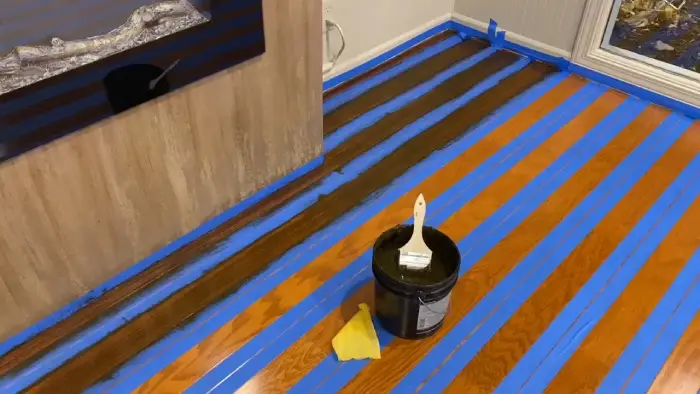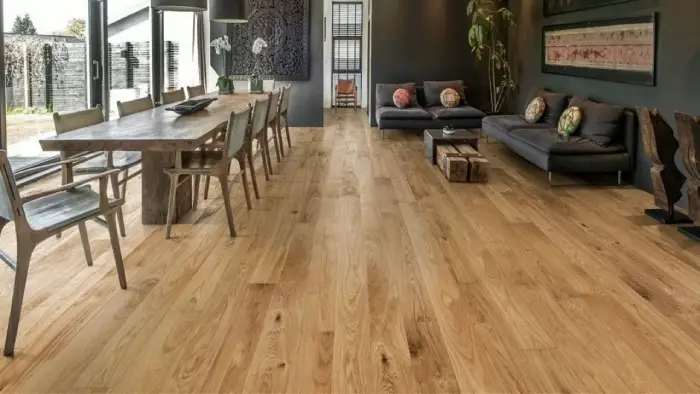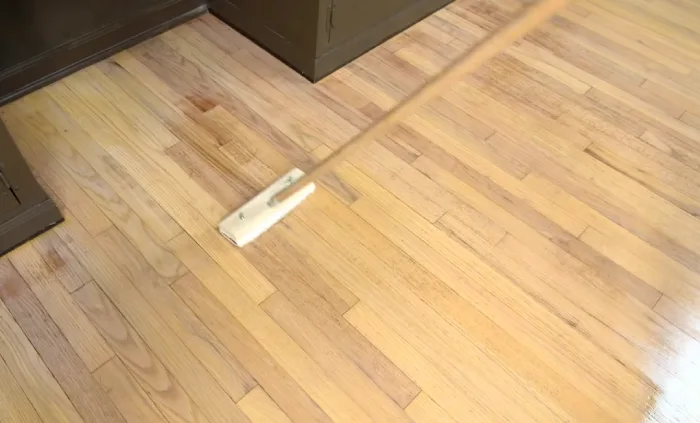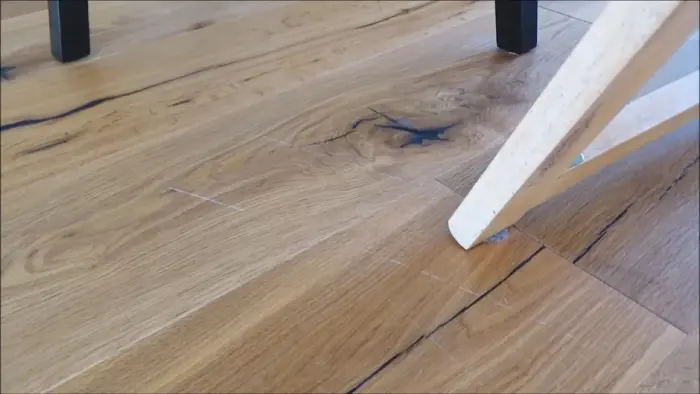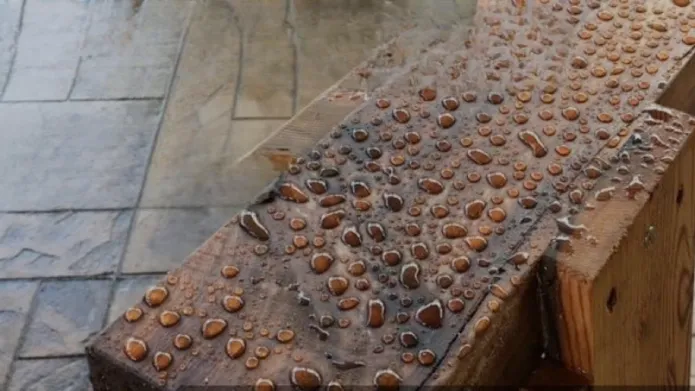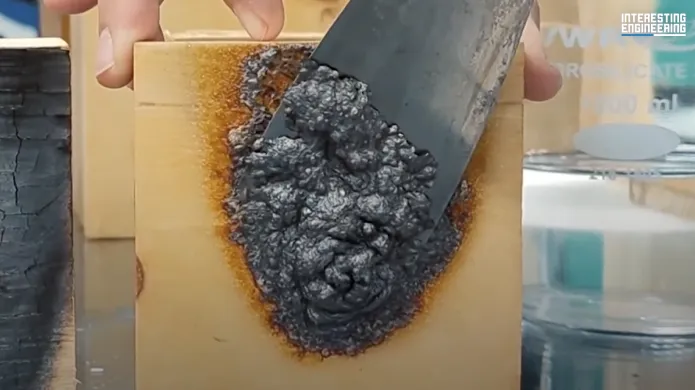You shouldn’t use harsh chemicals like ammonia, bleach, or vinegar on hardwood floors, as they strip finishes and cause discoloration.
Avoid soap-based cleaners, waxes, and oil-based products since they leave residues and dull the surface. Don’t let water pool or use abrasive tools that scratch the wood.
Also, high heels, dirty shoes, and improper furniture pads can damage the floor. For thorough guidance on preserving your hardwood’s finish and structure, keep exploring these essential precautions and tips.
Key Takeaways
- Avoid ammonia, bleach, vinegar, and other harsh chemicals that strip or damage hardwood floor finishes.
- Do not use soap-based cleaners, waxes, or oil-infused products that leave residues and dull the finish.
- Avoid abrasive tools like metal bristle brooms, hard brushes, and rough mop pads that scratch the wood surface.
- Do not let standing water or excessive moisture sit on floors to prevent swelling, warping, and finish peeling.
- Avoid high heels, pet nails, and dragging heavy furniture without protective pads that cause dents and scratches.
Harsh Chemicals That Damage Wood
Although cleaning hardwood floors is essential for maintenance, you should never use harsh chemicals like ammonia-based cleaners, bleach, or toilet bowl cleaners, as they can strip finishes and cause irreversible damage to the wood surface.
Ammonia-based cleaners break down the protective finish, leading to discoloration and surface degradation. Bleach, with its strong oxidizing properties, removes finishes and weakens the wood fibers.
Toilet bowl and bathroom cleaners often contain corrosive agents that aggressively erode finishes and wood. Immediate cleanup of chemical spills is crucial because letting them dry can cause noticeable damage.
Additionally, floor strippers, quaternary ammonium compounds, and acidic or alkaline cleaners can etch, discolor, or degrade the wood finish if not used cautiously.
Using improper cleaners during the finish’s curing time can severely compromise the floor’s durability. Chemical spills cause immediate and long-term damage, including finish removal, color alteration, and structural compromise.
Products That Leave Residue or Build-Up
You should avoid soap-based cleaners, waxes, polishes, and oil-infused products on hardwood floors because they tend to leave sticky residues or build-up.
These materials attract dust and grime, dulling the finish and creating a film that’s difficult to remove. Over time, this residue compromises the wood’s appearance and may require specialized cleaning to restore.
Improper dilution of cleaner increases residue and stickiness, making it crucial to follow manufacturer instructions carefully to prevent this residue buildup. Using the wrong tools or excessive water during cleaning can also contribute to persistent floor cleaner residue.
Soap-Based Cleaners
When cleaning hardwood floors, soap-based cleaners often leave behind a residue that dulls the finish and creates slippery surfaces. This residue buildup not only weakens the protective polyurethane layer but also causes chemical adhesion failures, complicating future refinishing efforts.
Oil soaps, in particular, penetrate the finish, risking permanent discoloration and fading. Over time, repeated use accelerates finish deterioration, necessitating costly repairs or replacement.
Additionally, the slippery residue increases accident risks on your floors. To avoid these issues, steer clear of soap-based products not specifically formulated for hardwood.
Instead, use water-based cleaners, microfiber mops, or diluted vinegar solutions. These alternatives clean effectively without compromising the floor’s integrity or finish, preserving both safety and the long-term aesthetic appeal of your hardwood flooring.
Wax and Polishes
Soap-based cleaners can leave residues that dull hardwood floors, but wax and polish products introduce a different set of challenges related to buildup and surface layering.
These products often create protective films that trap dirt and grit beneath, leading to dullness, cloudiness, and obscured wood grain. Additionally, environmental factors such as humidity levels can exacerbate the buildup issues by affecting how wax and polish dry on the surface.
Overuse causes thick, uneven layers that complicate maintenance and future refinishing. Many conventional waxes and polishes aren’t compatible with modern finishes, risking damage or white spotting due to moisture or chemical reactions.
To safely remove buildup, using mineral spirits cautiously with good ventilation and spot testing is recommended.
To avoid buildup, apply wax or polish sparingly, only when necessary, and always on clean surfaces using manufacturer-approved products.
If buildup occurs, remove it with an ammonia solution or specialized hardwood cleaners, testing first in an inconspicuous area. Mechanical buffing may be required for severe layers.
Oil-Infused Products
Although oil-infused products can enhance the appearance of hardwood floors, they often leave residues that accumulate over time, requiring frequent cleaning and careful maintenance.
These residues can interfere with existing finishes, degrade protective coatings, and cause discoloration or warping due to increased moisture sensitivity.
Over-oiling exacerbates buildup and may result in sticky surfaces. To protect your floors, avoid using incompatible oils and excessive amounts. Instead, opt for manufacturer-recommended maintenance products or natural oil finishes like tung or linseed oil, which penetrate and harden within the wood.
Regularly inspect and clean your floors with specialized hardwood cleaners. Maintain stable humidity levels and address spills immediately to prevent damage.
Proper care reduces the need for oil-infused products and preserves your hardwood floor’s integrity. Always ensure to dry floors completely after cleaning to prevent moisture damage and prolong the wood’s lifespan.
Cleaning Tools That Cause Scratches
Since hardwood floors require gentle care, using the wrong cleaning tools can quickly cause scratches and damage. Avoid brooms with metal bristles, abrasive mop heads, hard cleaning brushes, and vacuum attachments with hard plastic or metal edges.
Also, rough cleaning pads can degrade the finish and scratch the wood surface. Regularly inspect and maintain your tools to prevent debris buildup that can cause additional scratching.
Use only soft, non-abrasive materials designed specifically for hardwood floors. Consistent maintenance using specific cleaning formulas helps preserve the natural look and integrity of hardwood floors.
Additionally, maintaining proper humidity levels can help prevent wood damage that may worsen scratches and wear over time.
| Cleaning Tool | Risk of Damage |
|---|---|
| Metal Bristle Broom | Scratches from stiff metal tips |
| Abrasive Mop Head | Damages finish, scratches wood |
| Hard Cleaning Brush | Scratches from stiff bristles |
| Vacuum Attachments | Scratches from hard edges |
| Rough Cleaning Pads | Scratches and finish damage |
Improper Use of Water and Moisture
While selecting the right cleaning tools helps prevent surface scratches, managing water and moisture is equally important to maintain hardwood floor integrity.
Excess standing water seeps into wood fibers, causing swelling, warping, and discoloration. You must remove water immediately using dry mops, towels, or wet-vacs to avoid irreversible damage. Wood is hygroscopic, expanding and contracting with humidity changes, which makes moisture control critical.
Regularly maintaining proper humidity levels can also help prevent wood expansion or contraction that damages floors.
Avoid soaking the floor during cleaning; use a damp microfiber mop instead, working in sections and drying each area promptly. Maintain indoor humidity between 35–55% to prevent expansion, contraction, or cupping of floorboards.
- Standing water pools cause structural weakness and warping.
- Overly wet mops increase moisture penetration risk at seams.
- Fluctuating humidity levels lead to gaps or buckling.
Footwear and Objects That Harm Floors
Because certain types of footwear and objects exert concentrated pressure or abrasive forces, they can cause significant damage to hardwood floors.
High heels and metal spikes create deep scratches and dents due to their pointed edges. Dirt-covered or worn-out soles carry abrasive particles that scratch the finish. Heavy boots inflict impact damage, while pets’ nails and outdoor debris further abrade surfaces.
Additionally, wearing shoes indoors leads to dirt and debris transfer that can exacerbate floor wear. Regular cleaning and maintenance are crucial to minimize the accumulation of these damaging particles on hardwood surfaces.
Furniture without protective pads, heavy appliances moved carelessly, and objects with sharp edges can gouge or dent floors. Wheels and casters lacking protective covers also contribute to wear.
Using felt furniture pads is a simple yet effective method to prevent dents and scuffs caused by heavy items. Proper care and inspection of wheels and pads help to prevent inadvertent floor scratches and damage during everyday use.
To prevent damage, use shoe racks and floor mats to minimize debris, apply felt pads on furniture legs, and employ moving blankets or hardboard slides during relocations.
Wheel covers and floor protectors are essential for safeguarding hardwood flooring from mechanical stress and abrasion. Additionally, avoid dragging heavy items and instead lift them to reduce friction and potential surface scratches.
Unsuitable Cleaning Solutions and Polishes
Although you might be tempted to use common household cleaners on hardwood floors, many cleaning solutions and polishes can damage the wood or its finish.
Acidic substances like vinegar cause etching, while ammonia dulls and discolors the surface. Excess moisture from water or steam can warp or peel the finish. Using improper cleaning methods can also affect the floor’s long-term performance and durability.
Avoid professional-grade products unless specified for your floor type. Similarly, resist applying floor waxes, liquid polishers, or restorers, as they often degrade specialty finishes and may void warranties. Using unapproved cleaning techniques can accelerate floor aging and cause inconsistent results.
Unsuitable items include:
- Vinegar and ammonia-based cleaners that harm finish integrity.
- Floor waxes and liquid polishers that cause finish deterioration.
- Excessively wet mops or steam cleaners that introduce damaging moisture.
Seasonal Factors That Affect Floor Integrity
When you consider how seasonal changes affect hardwood floors, you must account for the wood’s natural response to humidity and temperature fluctuations. Wood expands in high humidity, risking buckling or cupping, while dry air causes contraction, leading to gaps between boards.
Temperature extremes intensify these effects, potentially causing warping or cracking. Different wood species vary in sensitivity—oak resists better than softer woods—and engineered wood offers enhanced stability against seasonal shifts.
Maintaining indoor humidity between 30%-50% helps stabilize wood movement and reduces risks of damage. Proper installation practices, including leaving an expansion gap, are essential to accommodate this natural movement.
To protect your floors, manage indoor humidity with humidifiers or air conditioning and maintain consistent temperatures to reduce thermal stress. Acclimate wood before installation and schedule it during stable seasons.
Frequently Asked Questions
Can Pet Urine Permanently Stain Hardwood Floors?
Yes, pet urine can permanently stain hardwood floors if you don’t act quickly. The urea in urine breaks down into ammonia, which alters the wood’s color and texture, especially on unsealed or poorly sealed floors.
If you delay cleaning, stains can penetrate deeply, causing discoloration and structural damage. Prompt, proper treatment is vital to prevent long-term damage and preserve your hardwood floors’ appearance and integrity.
How Often Should Hardwood Floors Be Professionally Refinished?
Frequent foot traffic forces you to frequently refinish hardwood floors. Typically, you’ll want professional refinishing every 7-10 years in busy areas, while low-traffic zones might last 10-15 years.
Maintenance matters, regular cleaning extends durability. Experts recommend evaluating finish type, wear, and environmental exposure.
For moderate use, screening and recoating every 3-5 years can help, but full refinishing involves sanding and resealing to restore your floor’s original brilliance and protection.
Are Steam Cleaners Safe for Hardwood Floors?
You shouldn’t use steam cleaners on hardwood floors because the moisture and heat can cause swelling, warping, and finish breakdown. Even sealed hardwoods are vulnerable, and steam can penetrate the protective layer, leading to damage.
To protect your floors, stick with vacuuming, dry mopping, or damp mopping using microfiber cloths and manufacturer-approved cleaners. Following expert recommendations helps maintain the wood’s integrity and prolongs its lifespan.
What Is the Best Way to Remove Tough Stains From Hardwood?
To remove tough stains from hardwood, start by spot-testing a hydrogen peroxide and water mix, applying it gently and blotting without soaking.
For stubborn spots, use a baking soda paste and softly scrub with a brush or cloth. Avoid rubbing harshly to protect the finish.
If the floor is non-coated, you can cautiously try No. 000 steel wool with floor wax for ink or pet stains. Always test first to prevent damage.
Can Sunlight Cause Hardwood Floors to Fade or Discolor?
Yes, sunlight can definitely cause your hardwood floors to fade or discolor. UV rays break down the wood’s pigments, leading to bleaching or darkening depending on the species.
Tropical woods like Brazilian Cherry darken, while domestic types like Maple tend to lighten. Visible light and infrared heat also contribute to color changes and finish degradation.
To protect your floors, use UV-blocking windows, window treatments, or rugs to limit direct sunlight exposure.
Handle Your Hardwood Floors with Care, Not Regret
If you’re aiming to turn your hardwood floors into a modern art masterpiece of scratches, stains, and residue, go ahead—grab that bleach, soak the mop, and wear cleats indoors.
But if you’d prefer floors that actually last and look great, steer clear of harsh chemicals, abrasive tools, and puddles. Treat your wood like the delicate, moisture-sensitive marvel it is, or prepare to enjoy the rustic charm of permanent damage. Your call.

